 The Savannah River Site (SRS), celebrating its 70th anniversary this year, was featured at the Waste Management Symposia. A panel of site and community leaders highlighted the site’s history and accomplishments. From left, panel co-chairs Amy Boyette of Savannah River Site External Affairs and Larry Ling of Savannah River Remediation; SRS Manager Mike Budney; Nicole Nelson-Jean, manager of the Savannah River Field Office for the National Nuclear Security Administration; Stuart MacVean, president and CEO of Savannah River Nuclear Solutions; Tom Foster, chief operating officer of Amentum’s nuclear and environment strategic business unit; and Rick Osbon, mayor of Aiken, South Carolina
PHOENIX – Led by a video message from Energy Secretary Dan Brouillette, leaders of the Savannah River Site (SRS) celebrated its 70th anniversary and its role as the featured site at the Waste Management Symposia.
At a special SRS anniversary panel during the conference, SRS Manager Mike Budney offered a history of the installation and a perspective on the site’s future. He was joined by leaders of the site’s major contractors, the manager of the National Nuclear Security Administration’s (NNSA) Savannah River Field Office, and Rick Osbon, mayor of Aiken, South Carolina.
Other panels during the conference featured discussions of work performed by Savannah River National Laboratory (SRNL) as well as talks on the site’s plans and achievements for treating liquid waste and managing nuclear materials.
In his message, Secretary Brouillette thanked past and current employees for their efforts. The site’s mission areas include environmental stewardship and the disposition of nuclear materials, and SRS plays a major role in the U.S. nuclear deterrent. Besides SRNL, SRS is also home to the University of Georgia’s Savannah River Ecology Laboratory, which has been monitoring the environmental impacts at SRS since the onset of work at the site.
Budney emphasized that the entire site is dedicated to the safety of employees and the environment, and highlighted the site’s strong safety record.
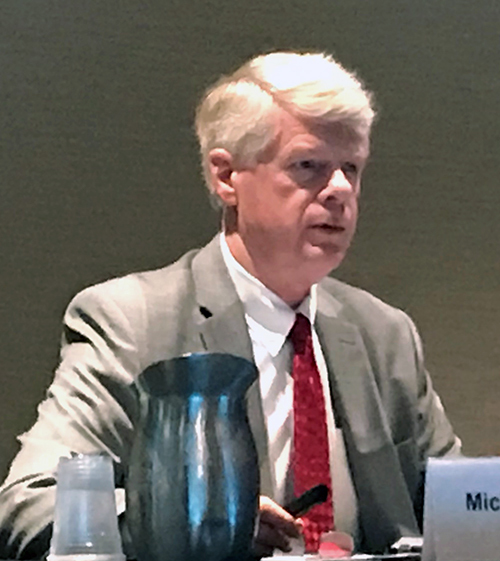 |
|
Savannah River Site Manager Mike Budney emphasized the site’s strong safety record. |
Nicole Nelson-Jean, manager of the National Nuclear Security Administration's Savannah River Field Office, said a nuclear security mission has been a feature of the site since its inception 70 years ago. |
|
 |
Nicole Nelson-Jean, manager of the NNSA Savannah River Field Office, described the agency’s role at the site. She noted NNSA was celebrating its 20th anniversary as a formal entity but that the government nuclear security mission has been a part of SRS since the beginning of the site.
Stuart MacVean, president and CEO of Savannah River Nuclear Solutions (SRNS), highlighted SRNS mission areas such as the national laboratory, the Mark 18 isotope program, and the growth of cyber missions.
 |
|
Stuart MacVean, president and CEO of Savannah River Nuclear Solutions, and Tom Foster, chief operating officer of Amentum’s nuclear and environment strategic business unit, highlighted the major work contractors perform at the Savannah River Site. |
Rick Osbon, mayor of Aiken, South Carolina, touted the community’s long and strong support for the Savannah River Site. |
|
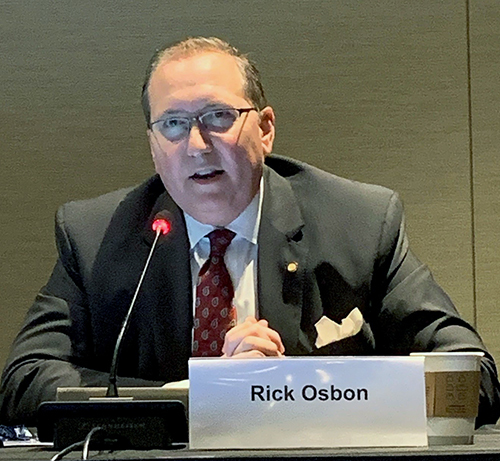 |
Tom Foster, chief operating officer of Amentum’s nuclear and environment strategic business unit, gave an overview of the SRS liquid waste mission, including the site’s liquid waste tank farms. Eight of the 51 tanks have been closed so far. Foster highlighted the Salt Waste Processing Facility that is scheduled to come online soon and significantly increase waste treatment capabilities.
Osbon said the community has worked hand in hand with SRS for the site’s entire 70 years. He said about 45 percent of the SRS workforce lives in Aiken, and the community has a strong sense of patriotism and trust in the site for its safety success.
-Contributor: Barbara Smoak
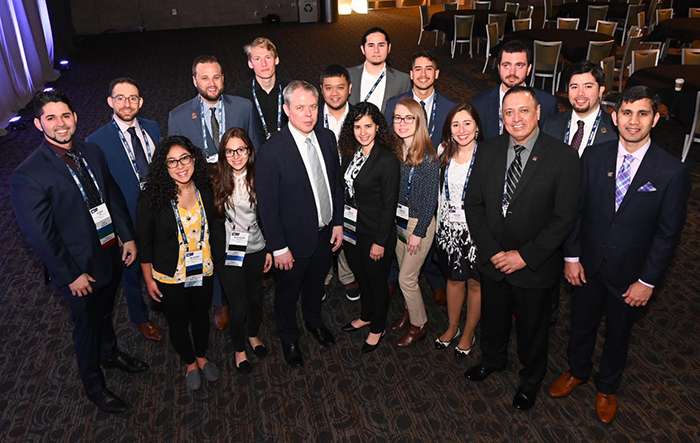 PHOENIX – EM Senior Advisor William "Ike" White, front row, third from left, gathered with Florida International University (FIU) DOE Fellows at the Waste Management Symposia. The DOE-FIU Science and Technology Workforce Development Initiative has been designed to build on the DOE-FIU relationship by creating a “pipeline” of minority engineers specifically trained and mentored to enter the DOE workforce in technical areas of need. This innovative program was designed to help address DOE’s future workforce needs by partnering with academic, government, and DOE contractor organizations to mentor future minority scientists and engineers in the research, development, and deployment of new technologies, addressing DOE’s environmental cleanup challenges. Leo Lagos, director of the DOE Fellows at FIU, is second from right in the front row. Photo Courtesy Flash Gordon Murray.
PHOENIX – Students and workers trained in science, technology, engineering, and math (STEM) fields are increasingly critical to DOE programs that are challenged to maintain technically skilled workforces, EM Principal Deputy Assistant Secretary Todd Shrader told an audience at the Waste Management Symposia.
Shrader said workers in STEM professions have a good chance to make their mark in EM, which projects big accomplishments over the next decade at its 16 cleanup sites across the DOE complex.
“We are trying to make significant progress over the next 10 years that is going to create tremendous opportunity for the next generation coming in behind us,” he said. “Workers in the STEM field are vital to our mission.”
The EM official was keynote speaker at a STEM/DOE Workforce Initiative Summit held at the waste management conference. The summit brought together government, labor, and corporate experts to discuss best practices in recruiting, developing, and retaining talented and diverse workforces in the STEM fields.
Shrader noted employment in STEM occupations has grown 79 percent since 1990 — from 9.7 million to 17.3 million jobs. At DOE, the average grade of workers in STEM fields like information technology, engineering, or physical sciences is GS-13, earning an average $127,000 annually.
Still, the government needs to add thousands of new engineers each year just to keep pace with its needs.
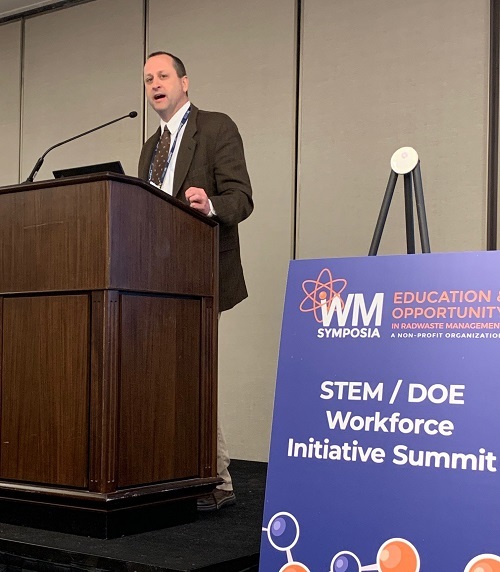 |
|
EM Principal Deputy Assistant Secretary Todd Shrader was keynote speaker at a STEM/DOE Workforce Initiative Summit held at the Waste Management Symposia. |
Shrader outlined a variety of EM initiatives that aim to spark STEM interest in young students. At cleanup sites, these include science bowls, job shadowing opportunities, and family science days.
On the university level, EM’s partnership with the Applied Research Center at Florida International University has provided support through a cooperative agreement. EM also participates in the Minority Serving Institutions Partnership Program that combines technical research with internships. For graduate students, EM traineeships are developed in partnership with the national laboratories.
Shrader said energy professionals “need to get out talking about the exciting possibilities, the exciting work, the career opportunities for engineers and scientists of the future, the students of today. I’m always encouraged when I see companies doing more and more of that, and the national labs. Certainly on the federal government side, we are trying to do that.”
“At the end of the day, EM is working really hard to nurture the STEM areas, to advance the STEM areas,” Shrader said.
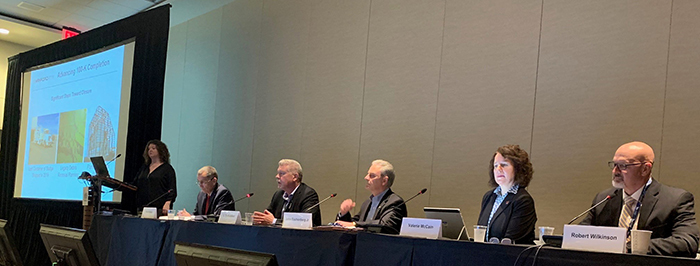 From left, seated, Hanford Site Manager Brian Vance, Ty Blackford, president of CH2M HILL Plateau Remediation Company, John Eschenberg, president and CEO of Washington River Protection Solutions, Valerie McCain, principal vice president and Waste Treatment and Immobilization Plant Project director for Bechtel National, Inc., and Bob Wilkinson, president of Mission Support Alliance.
PHOENIX – Hanford Site Manager Brian Vance and leaders of the site’s major cleanup contractors expressed pride in recent accomplishments and optimism about progress toward liquid waste treatment during a panel discussion at the Waste Management Symposia.
“We’ve had a phenomenal last 30 years of cleanup, particularly on Hanford’s River Corridor,” Vance said. “And now the focus transitions to Hanford’s Central Plateau.”
Washington River Protection Solutions President and CEO John Eschenberg, whose company manages the mission of retrieving 56 million gallons of waste stored in underground tanks, described a shift in the culture at Hanford as workers advance toward treating the waste. Construction on facilities supporting Direct-Feed Low-Activity Waste (DFLAW) treatment is expected to be completed this year, a key step toward commissioning and operations.
“There is excitement in the air at Hanford because we’ve been working toward this end for decades,” Eschenberg said.
He added that Hanford’s senior leaders have come together as a team to get ready to make glass out of the tank waste.
“We are a team now. We can feel it. We are a fully integrated enterprise,” Eschenberg said. “Now I talk about making glass as much as emptying tanks.”
Valerie McCain, principal vice president of Bechtel National, Inc., and project director for the Waste Treatment and Immobilization Plant (WTP) Project at Bechtel, agreed. She described efforts in WTP construction, commissioning progress, and development of the future workforce,
“It’s an exciting time on the project and in this mission. It feels different,” McCain said. “It’s a privilege to be part of this team. People are definitely coming together to get the job done.”
Bob Wilkinson, president of services contractor Mission Support Alliance (MSA), said his company celebrates the site’s successes as part of the team.
“Their success is our success and Hanford’s success. We celebrate with them, because we’re in there together,” Wilkinson said. “We enable, we create, and we ensure they have reliability of essential services required to meet such significant milestones. The entire workforce across the site is pulling toward the goal of treating the waste.”
Ty Blackford, president and CEO of cleanup contractor CH2M HILL Plateau Remediation Company, recounted two recent major completions at Hanford among his company’s work — transferring sludge out of the K West reactor basin and completing cleanout and wrapping up demolition of the Plutonium Finishing Plant (PFP).
“PFP was one of the highest hazard buildings at Hanford and arguably in the complex,” he said. “It’s gone; it’s not there anymore.”
Vance said there is a sense of optimism about Hanford cleanup.
“It’s really about all of us working together, so we come together at that critical point when we’re all ready to start making glass,” he said. “We’ve shown our ability to progress cleanup in the past and we will continue to do so in the future.”
-Contributor: Cameron Hardy
PHOENIX – EM’s Portsmouth/Paducah Project Office (PPPO) is set to make the first major skyline change later this year with demolition beginning on the X-326 process building at Portsmouth, site leaders said at the Waste Management Symposia.
The Portsmouth Site is currently in the final stages of demolition preparation for the building, completing necessary support systems and paperwork to begin taking down the massive structure. Material from the demolition will be the first waste emplaced in the site’s Onsite Waste Disposal Facility, which will become operational in the fall with the first two cells completed.
Lessons learned from the deactivation of X-326 are being translated into real-time lessons learned for the Paducah Site, which is deactivating its C-333 process building.
Paducah’s deactivation efforts will also wean the site off plant-dependent power next year as the Tennessee Valley Authority completes a new substation to provide electricity for cleanup.
“The collective synergy between the cleanup of the two sites not only maximizes cost and schedule, but results in the most comprehensive approach to cleanup,” said Robert Edwards, PPPO manager.
Edwards is centralizing support functions at PPPO headquarters in Lexington, Kentucky to better serve the sites and their stakeholders. The “One PPPO” vision extends to cleanup at Portsmouth and Paducah, and also the depleted uranium hexafluoride (DUF6) conversion plants that operate at both sites.
The conversion plants are currently running all seven lines, exceeding production goals for the year.
-Contributor: Yvette Cantrell
 Members of the panel focused on the return on investment in EM technology include, from left, Kurt Gerdes, director of EM's Technology Development Office; Connie Herman, associate laboratory director, chemical and environmental sciences, Savannah River National Laboratory (SRNL); Jud Virden, associate laboratory director at Pacific Northwest National Laboratory; Carol Eddy-Dilek, SRNL senior technology advisor; Vijay Jain, chief technology officer at Savannah River Remediation; and Martin Williams, senior vice president and chief operating officer at NuVision Engineering.
PHOENIX – Technology’s pivotal role in advancing EM’s mission was the focus of a panel at the Waste Management Symposia.
Panel co-chairs Kurt Gerdes, director of EM's Technology Development Office, and Connie Herman, associate laboratory director, chemical and environmental sciences, Savannah River National Laboratory (SRNL), highlighted complex-wide initiatives that have shown a significant return on investment.
Jud Virden, associate laboratory director at Pacific Northwest National Laboratory, shared how the laboratory has been successful with a wide range of technologies. Examples included melter technology, in-situ characterization of tank residuals, subsurface energy systems, and spray release methodology. Virden noted that science and technology deliver the biggest impact to the EM mission when near- and long-term issues are identified in the field, and key science and technology capabilities are strategically employed.
Carol Eddy-Dilek, SRNL senior technology advisor, highlighted EM’s Technology Development Technical Assistance Program, which has provided support to the DOE complex since 2000. The program’s objectives include improving the effectiveness of DOE’s environmental activities and incorporating science into the cleanup program. Eddy-Dilek noted that the program has had an impact across the complex, with team visits to 12 DOE sites.
Vijay Jain, chief technology officer with Savannah River Remediation (SRR), EM’s liquid waste contractor at the Savannah River Site (SRS), provided an overview of the liquid waste facilities at SRS. Jain also detailed the site’s objectives to immobilize high-level waste into glass and low-level waste into grout, and to close waste tanks. To achieve these objectives, SRR relies on its technology optimization blueprint, which encourages cooperation and coordination of ideas. Doubling the capacity of a glass waste storage building at SRS saved $100 million and demonstrated the effectiveness of optimizing technology.
Martin Williams, senior vice president and chief operating officer with NuVision Engineering, discussed lessons learned — some of which were echoed by other panelists — such as communicating the benefits of new technology to stakeholders, ensuring governments and agencies have an active role, and keeping the end user’s needs at the forefront of a technology strategy.
-Contributor: Steven Horak
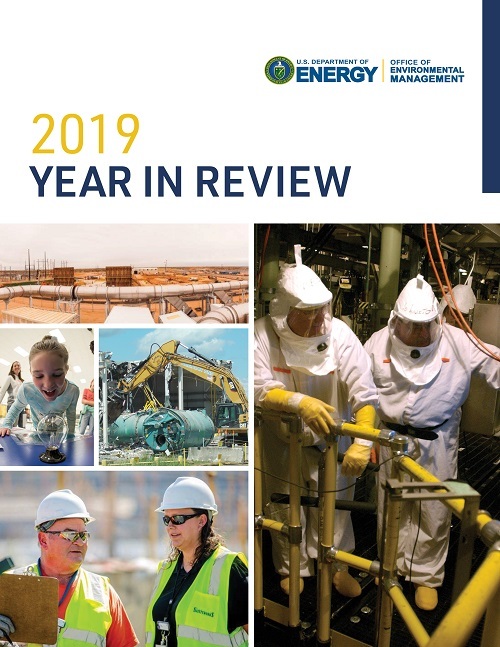 |
|
EM has published its 2019 Year in Review, summarizing the accomplishments of cleanup workers across the DOE complex over the course of the year. The booklet highlights major achievements at each EM site and at EM headquarters. The Year in Review can be found online here. |
|